Writer: Tiffany Whisner, Coles Marketing
It started out as a working lab, showing off assistive technology categorized by disability — for those individuals who are blind or vision-impaired; Deaf or Hard of Hearing; have mobility challenges; or learning or cognition challenges.
 Now, as the reality of the AT world is changing, the INDATA Project at Easter Seals Crossroads is unveiling a new technology lab — turning its focus to emulate community environments where people use technology all the time, like your home, work or school.
Now, as the reality of the AT world is changing, the INDATA Project at Easter Seals Crossroads is unveiling a new technology lab — turning its focus to emulate community environments where people use technology all the time, like your home, work or school.
“We wanted to make the lab more relatable to people,” said INDATA Director Wade Wingler. “Before, the space was optimized for people to be evaluated on AT devices that suited a particular disability. We want them to be able to visit our new lab and see all there is to offer to help them adapt to and thrive in their environment.”
“It’s one thing to see the technology with a specific disability,” said Manager of Clinical Assistive Technology Brian Norton. “It’s another to see it in an environment. Technology is so integrated in our everyday lives, and it makes sense to highlight how someone with a disability might really be impacted with this technology in how they move about their day.”
What was a technology workplace — is now a showcase for the latest and greatest the AT industry has to offer.
Moving with a mission
Less than two years ago, INDATA made a big move — from the fourth to the third floor of the Easter Seals Crossroads building. And with that move came new spaces, new ideas and new goals.
One of those goals was to introduce people with disabilities to all the technology available to them to assist them in their day-to-day lives. Mission accomplished with the new tech lab.
“This new lab is a way to make people more aware of all the assistive technology out there they never even knew existed,” Norton said.
 INDATA already had much of the technology included in the lab; some of it just needed updating.
INDATA already had much of the technology included in the lab; some of it just needed updating.
“Staying on top of the latest assistive technology is part of what we do,” Wingler said. “We try to keep track of those outlets and organizations focused on assistive technology, learning what the trends are and where product development is going. We are always adding to our collection.”
With Indiana’s largest staff of AT professionals, the INDATA team works daily with people with disabilities, answering their questions, demonstrating AT devices and educating them on ways they can make their lives easier with this technology.
“During our weekly staff meetings, we always talk about what our team members have been hearing out in the field, gathering inquiries from clients on new technology and propelling our mission forward to update the lab and strengthen our inventory with the technology people want and are asking for.”
So not only did INDATA move to a new physical location. They also moved on the implementation of the new lab space.
“There were some areas we did have to create,” Wingler said. “We had to set up the different environments — like a home, school and work — to make the technology easier for people to understand when they interact with it.”
Automation brings you home
As you first step into the new INDATA technology lab, you get a look at what seems to be a typical home environment — a table and chairs, lights and a TV. But a closer view lets you see how “smart” this home really is.
 A switch here. A sensor there. And the automation is completely customizable.
A switch here. A sensor there. And the automation is completely customizable.
“We are only using devices available in mass market stores, like Best Buy and Lowe’s,” Wingler said. “We are trying to use mainstream technology available to everyone and show how that technology can be used to enhance the lives of people with disabilities.”
One of those devices is the WeMO light switch by Belkin. Designed for use with most mobile devices, this Wi-Fi-enabled light switch lets you control and schedule the lights in your home to turn on and off based on your schedule and needs.
There are smart outlets, ways to adjust lighting and a video monitoring system to watch different areas of the home.
“A lot of us don’t really think about what it takes to interact with the environment when you’re in your home,” Norton said. “Whether it’s the security system, turning the channel on the TV or turning on an appliance, or just the physical access to a light switch, so much can be automated with technology these days.”
And the point is showing how a little automation can go a long way.
“With just a mobile device and some electricity, you can make a big part of your home accessible to people with disabilities in a very real way,” Norton said.
Oh and don’t forget about the adaptive kitchen utensils. They are all items people might use for everyday tasks but, when taken to the next level, they can help people with disabilities overcome a number of challenging tasks around the home.
“For the average person, these devices are just a convenience,” Norton said. “But for someone with a disability, it’s a necessity.”
Hi-tech devices make the grade
For a student with a disability, it’s a much different story when you step inside a classroom. In general education classrooms, group-focused learning with distractions and an instructor who may be hard to see or hear can certainly be barriers for grasping the daily lesson.
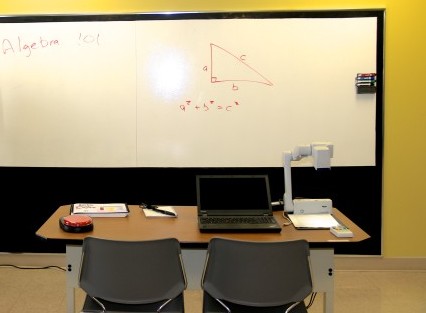 In the INDATA lab, the simulated classroom environment features a robotic video magnifier called the E-bot PRO.
In the INDATA lab, the simulated classroom environment features a robotic video magnifier called the E-bot PRO.
“The student can sit anywhere in the classroom or lecture hall and use the robotic magnifier on anything from the instructor’s face or whiteboard to an experiment or demonstration being done at the front of the room, and it will all show up on their laptop or iPad as a zoomed-in image,” Winger said.
Indeed, a student can view and interact with a reading, writing or image. Users can also navigate through reading material using a joystick control or touch-screen gestures that move the camera in response to a touch.
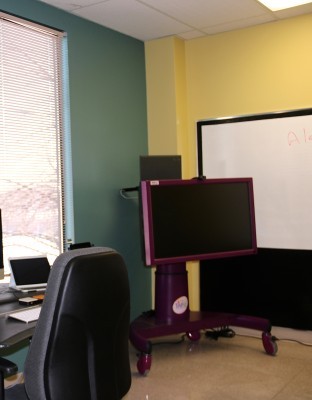 Lovingly called “Barney” by the INDATA staff for the kid-friendly, big, purple dinosaur, the TAP-it device is a big, purple interactive learning station on wheels. It provides an optimal interface for teaching students with disabilities and special needs at their own pace.
Lovingly called “Barney” by the INDATA staff for the kid-friendly, big, purple dinosaur, the TAP-it device is a big, purple interactive learning station on wheels. It provides an optimal interface for teaching students with disabilities and special needs at their own pace.
“You can move it around a classroom and place it where a child might normally sit and essentially ‘beam them in’ if they need to learn remotely,” Wingler said.
TAP-it is also accessible for students using wheelchairs, walkers or other mobility devices, giving them full reach capabilities to the 42” interactive LCD panel.
And Wingler makes note of a special note-taking device called the Livescribe.
“What someone writes down on paper shows up as a digital version on your iPad or tablet,” he said. “It gives students an accessible version to handwritten notes, which can also be played back as an audio file, and it backs up on your computer.”
Livescribe makes pen and paper notes more accessible in today’s digital lifestyle and is especially useful for people with disabilities. The smartpens have an infrared camera that detects pen strokes on special Livescribe paper, allowing the notes to be recorded digitally in real time.
All these devices offer ways for students with disabilities to get to the head of the class. And on their way to class, they can even take their technology with them.
Get in gear with wearable gadgets
“Everyone feels the impact of wearable, mobile technology,” Wingler said. “Assistive technology is on the move now. You don’t have to go back to your computer, and you aren’t tied to your desk in order to use your AT.”
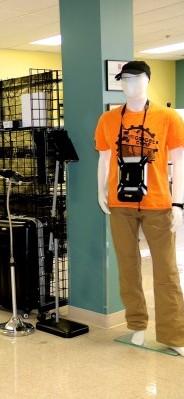 And in addition to wearable iPads, the INDATA tech lab has a few different smartwatches.
And in addition to wearable iPads, the INDATA tech lab has a few different smartwatches.
The Pebble smartwatch is waterproof, runs a ton of apps, and works with both iOS and Android phones. The e-paper display ensures a clear view, even in sunlight, and you can route all your emails and messages to the watch.
“I am fascinated with what they might be able to do with watches in the future,” Norton said. “Phones aren’t really wearable, so if you can capture all the information from a smartphone into a watch, that could help people with disabilities in all kinds of new ways.”
One of those ways, Norton pointed out, would be a prompting system.
“For people with autism or those on the autism spectrum, a smartwatch that prompts them to start and stop certain tasks is so helpful for their daily schedules.” It’s similar to the WatchMinder, a vibrating wristwatch that will privately cue you through your day. Right now, the WatchMinder is being used by both children and adults with Attention Deficit Disorder as well as people with chronic illnesses.
Most of these smartwatches are tied in to your smartphone’s operating system, whether it is Apple- or Android-based. But they always connect to your phone.
“I can’t wait until these smartwatches are totally standalone devices,” Norton said. “That way you don’t even have to be connected to your phone.”
And although Google Glass in its most recent form is no more, that doesn’t mean it’s dead. In fact, Google is already sending out prototypes of the next generation of Glass.
“These ‘face space’ devices will play into a lot of augmented reality ideas, giving a live view of a physical, real-world environment a different vision,” Wingler said. “People with disabilities can look at their present, physical world and get some assistance from either a computer or a loved one on certain social situations that might be confusing.”
For example, a student with a disability walks into an empty classroom and doesn’t know how to react. That particular piece of wearable technology may have an online system to tap into Wikipedia or YouTube or call a family member or friend, who can then let that student know how to handle the situation — whether class was cancelled for the day or they went to the wrong classroom.
“It’s all about having that authentic person help someone with a disability navigate a social situation and interact with the real world,” Wingler said.
The right position for work
 Ergonomics is the study of people’s efficiency in their working environment. And as a certified ergonomist, Norton has an added interest in INDATA’s zero-gravity workstation, part of the technology lab.
Ergonomics is the study of people’s efficiency in their working environment. And as a certified ergonomist, Norton has an added interest in INDATA’s zero-gravity workstation, part of the technology lab.
“Our workstation includes zero-gravity components and is height adjustable along with having an ergonomic keyboard to provide optimum ease and comfort to the person using it,” he said.
The fluid and adjustable reclining workstation helps a person with a disability avoid stress or injury to certain parts of the body.
“If you have a back impairment or if sitting or standing is a challenge at work, getting into that zero-gravity recliner allows you to lean completely back and alleviate all those pressures normally put on your back area,” Norton said.
He said ergonomics is really about fitting the work to the person and finding that sweet spot for them to work from by getting them in a more neutral position appropriate to their disability or disorder.
“Ergonomics can be impactful to anyone with a disability and is foundational to the whole assistive technology industry,” Norton said. “It helps position folks with disabilities or adjusts devices to their level to make what they are working with more accessible to them.”
Introduction to ARTI and robotics
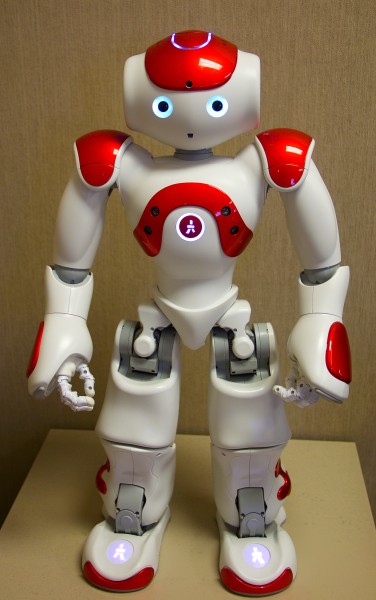 Another area INDATA is just beginning to touch the surface of is its new robotics program. A key to that program is the Assistive Robotics Technology Initiative — also known as ARTI the robot.
Another area INDATA is just beginning to touch the surface of is its new robotics program. A key to that program is the Assistive Robotics Technology Initiative — also known as ARTI the robot.
“We are still figuring out what all these robots can do and how we can use them to help people with disabilities,” Wingler said.
While doing some gift shopping for his family, Wingler came across some toy robots he thought were pretty cool. And he realized there were some assistive technology applications that could be applied to that robot — and it was just a toy.
“I did learn a lot of the toy robots have unintentional adaptive access methods for people with disabilities,” Wingler said. “The more I began to do research, the more I became aware of all the other applications they could have on an emotional, physical and behavioral level.”
One such application could be for kids with autism, who may have difficulty distinguishing and understanding people’s feelings.
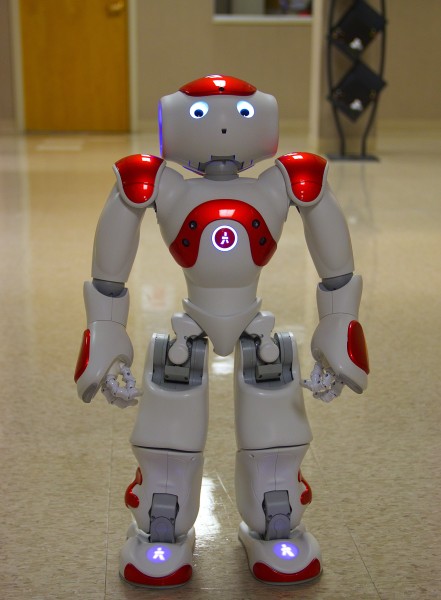 “A robot can be programmed to have a certain emotion, and the child is rewarded if they recognize it,” Wingler said. “Robots are able to be consistent with these emotions, which people often are not, and the child can learn to recognize that emotion while interacting with the robot in a much less intimidating situation than in a social environment where other people are judging them.”
“A robot can be programmed to have a certain emotion, and the child is rewarded if they recognize it,” Wingler said. “Robots are able to be consistent with these emotions, which people often are not, and the child can learn to recognize that emotion while interacting with the robot in a much less intimidating situation than in a social environment where other people are judging them.”
That toy robot prompted Wingler and the INDATA staff to look into some higher-tech robotics, and they found Aldebaran Robotics in France. Their NAO robot — renamed ARTI by INDATA — is a humanoid robot that moves, recognizes you, hears you and even talks to you.
“ARTI is more programmable and sophisticated with social interaction,” Wingler said. “He is able to do questions and answers with you and interact in a more human kind of way.” He’s also one of the first robots of his kind in Indiana.
Making AT more approachable
INDATA is having an open house on Tuesday, Mar. 3 from 2-6 to unveil this new technology lab and robotics program. It’s a way to let people with disabilities know what’s out there to help them with challenges in their day-to-day lives.
 “The big challenge is getting people to realize every device someone without a disability can use for convenience can also be used by someone with a disability to enhance that person’s quality of life and independence,” Norton said. “Assistive technology can have a profound impact on how a person with a disability interacts with people and their environment, excels in school, and performs in the workplace.”
“The big challenge is getting people to realize every device someone without a disability can use for convenience can also be used by someone with a disability to enhance that person’s quality of life and independence,” Norton said. “Assistive technology can have a profound impact on how a person with a disability interacts with people and their environment, excels in school, and performs in the workplace.”
At the open house, not only will attendees be able to view all different parts of the technology lab, but they can also get a look at the AT Museum, filled with a display of old AT devices — from super early hearing devices to rotary phones — when they were used and what they were used for by people with disabilities.
Norton will also be showing off INDATA’s recording studio, taking and answering questions live on the air from open house attendees.
 “Things are moving so fast in the technology world these days,” Norton said. “And it’s great to network with other people and find out what they are using to overcome their daily challenges. That helps us at INDATA stay on top of the technology as best we can so we can continue to be a resource for others.”
“Things are moving so fast in the technology world these days,” Norton said. “And it’s great to network with other people and find out what they are using to overcome their daily challenges. That helps us at INDATA stay on top of the technology as best we can so we can continue to be a resource for others.”
“We want people to understand assistive technology doesn’t have to be super expensive,” Wingler said. “This open house is a great way to show off the best AT in the most approachable and user-friendly way possible.”
